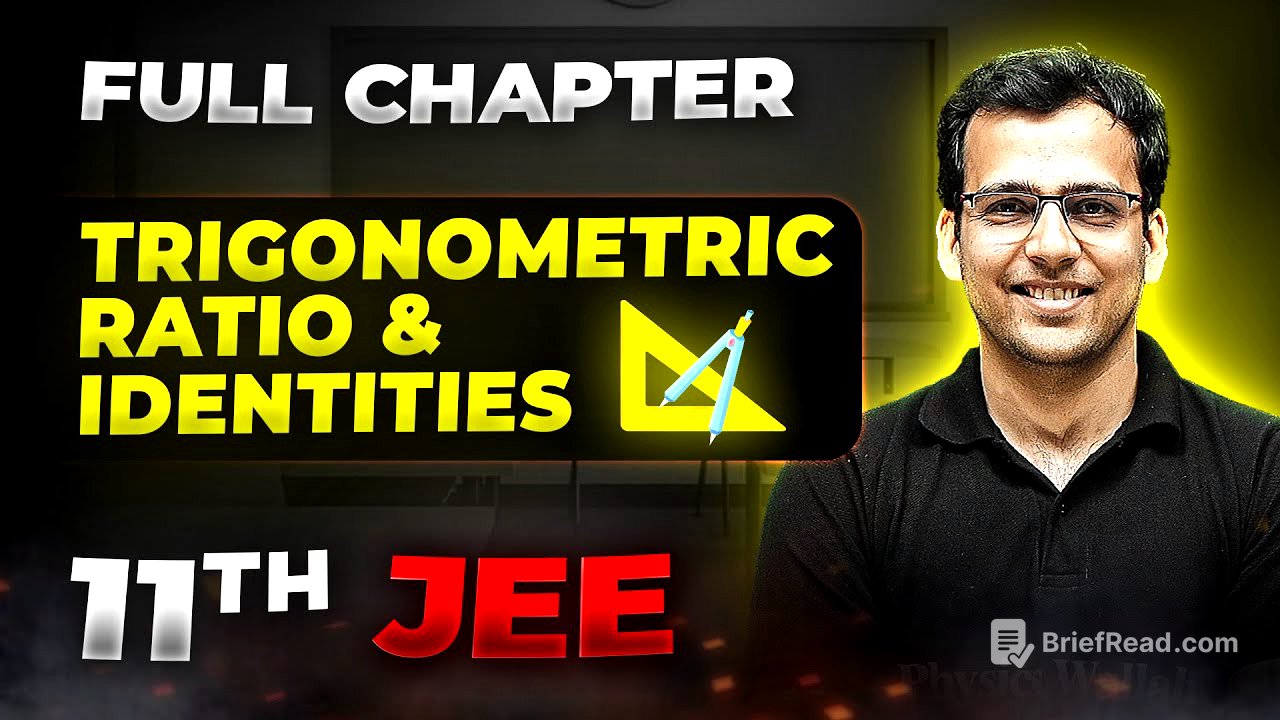TLDR;
This video provides a comprehensive one-shot lecture on Trigonometry Ratio and Identity, targeting students preparing for JEE and other competitive exams. The lecture covers fundamental concepts, formulas, and problem-solving techniques, emphasizing the importance of understanding and memorizing key formulas. It includes topics ranging from basic trigonometric ratios to advanced concepts like allied angles, compound angles, and factorization formulas.
- Trigonometry Ratios and Identities
- Radian Measure and Sign Conventions
- Compound, Multiple, and Sub-Multiple Angles
- Factorization and Defactorization Formulas
- Graphs of Trigonometric Functions
- Range of Trigonometric Functions and Problem Solving
Introduction [0:00]
The lecture is designed for students with varying levels of understanding, from those needing to clear backlogs to those seeking a quick revision. The speaker introduces himself as Tarun Khandelwal and outlines the lecture's structure, which includes basics, NCERT-level concepts, and advanced topics. The primary goal is to help students master trigonometric formulas and apply them effectively in problem-solving.
Radian Measure [10:40]
This section explains radian measure as an alternative unit to degrees for measuring angles. It defines the relationship between radians and degrees, stating that π radians equal 180 degrees. The conversion between degrees and radians is illustrated with examples, such as π/2 radians equaling 90 degrees. The lecture also covers subdivisions of a degree into minutes and seconds, explaining the need for precision in angle measurements, especially in fields like astronomy.
Sign Convention [23:18]
The lecture introduces the sign convention for angles, explaining that angles measured in the anticlockwise direction are positive, while those measured clockwise are negative. The importance of specifying the direction of angle measurement is emphasized, especially in advanced trigonometry. The concepts of initial and terminal sides of an angle are defined to clarify the direction of measurement.
Negative Angle Formulas [29:47]
This segment focuses on negative angle formulas, providing a simple technique to remember them. It states that cos(-θ) = cos(θ) and sec(-θ) = sec(θ), meaning the negative sign disappears for cosine and secant functions. For all other trigonometric functions, the negative sign comes out, such as sin(-θ) = -sin(θ).
ASTC Rule [32:19]
The ASTC (All, Sine, Tan, Cosine) rule is explained to determine which trigonometric functions are positive in each quadrant. The quadrants are numbered in an anticlockwise direction, with the first quadrant (0° to 90°) having all functions positive, the second quadrant (90° to 180°) having sine and cosecant positive, the third quadrant (180° to 270°) having tangent and cotangent positive, and the fourth quadrant (270° to 360°) having cosine and secant positive. The lecture also clarifies that adding or subtracting 360 degrees to any angle does not change its trigonometric function value.
Allied Angles [43:58]
Allied angles are defined as angles whose sum or difference is a multiple of 90 degrees. The lecture provides a method to derive formulas for allied angles using three steps: determining the quadrant, checking the sign of the trigonometric function in that quadrant, and deciding whether the function remains the same or changes (sine to cosine, tangent to cotangent, etc.). The rule is that trigonometric ratios associated with 180° and 360° remain the same, while those associated with 90° and 270° change.
Table [56:58]
The lecture presents a table of trigonometric values for standard angles (0°, 30°, 45°, 60°, 90°) and extends it to angles like 120°, 135°, and 150° using allied angle formulas. A trick is shared to quickly determine the values by relating them to their acute angle counterparts and considering the sign based on the quadrant.
Compound Angles [1:14:35]
Compound angles involve formulas for trigonometric functions of sums and differences of angles, such as sin(A + B) and cos(A - B). The lecture presents these formulas and briefly touches upon their proofs using vector algebra. An example problem is solved to illustrate the application of compound angle formulas. The values of sin 15°, cos 15°, tan 15°, and tan 75° are highlighted as important to remember.
Double Angles [1:31:01]
Double angle formulas express trigonometric functions of 2θ in terms of trigonometric functions of θ. The key formulas discussed are sin 2θ = 2sinθcosθ, cos 2θ = cos²θ - sin²θ = 2cos²θ - 1 = 1 - 2sin²θ, and tan 2θ = (2tanθ) / (1 - tan²θ). The lecture emphasizes the importance of memorizing these formulas and knowing when to apply each one. The value of tan 22.5° is derived and highlighted as important.
Triple Angles [1:59:53]
Triple angle formulas express trigonometric functions of 3θ in terms of trigonometric functions of θ. The formulas presented are sin 3θ = 3sinθ - 4sin³θ and cos 3θ = 4cos³θ - 3cosθ.
Multiple Angles [2:03:15]
Multiple angles are a generalization of double and triple angles, where trigonometric functions of nθ are expressed in terms of trigonometric functions of θ. The lecture explains that double angle formulas can be applied repeatedly to express trigonometric functions of any multiple angle.
Sub-Multiple Angles [2:05:40]
Sub-multiple angles involve expressing trigonometric functions of θ in terms of trigonometric functions of θ/2. The lecture explains how double angle formulas can be rearranged to derive sub-multiple angle formulas.
Factorization & Defactorization Formulas [2:20:14]
Factorization formulas (also known as sum-to-product formulas) express sums or differences of trigonometric functions as products. Defactorization formulas (also known as product-to-sum formulas) do the opposite. The lecture presents these formulas and provides a trick to remember them.
Graphs of Trigonometric Functions [2:33:09]
The lecture briefly discusses the graphs of trigonometric functions, including sine, cosine, and tangent. It highlights key features such as the domain, range, and periodicity of each function. The graphs of sine and cosine are compared, and the concept of finding points where sin(x) = cos(x) is explained.
Extra Formulas [2:49:37]
This section introduces additional formulas that are useful for problem-solving but are not typically covered in NCERT textbooks. These include formulas for sin 18° and cos 36°.
Extra Formulas-2 [3:07:02]
More extra formulas are presented, including sin²A - sin²B = sin(A + B) * sin(A - B) and cos²A - sin²B = cos(A + B) * cos(A - B).
Extra Formulas-3 [3:33:01]
The formulas for the product of three cosine terms: cos θ * cos(60 - θ) * cos(60 + θ) = 1/4 cos 3θ and sine terms: sin θ * sin(60 - θ) * sin(60 + θ) = 1/4 sin 3θ.
Extra Formulas-4 [3:34:46]
The lecture discusses formulas for summing trigonometric series where angles are in arithmetic progression.
Range of Trigonometric Functions [4:02:09]
The range of trigonometric functions is discussed, with a focus on the range of expressions of the form a sin(x) + b cos(x), which is [-√(a² + b²), √(a² + b²)].
PYQs [4:16:52]
Several past year questions (PYQs) from JEE Main are solved to illustrate the application of the discussed concepts and formulas.
Thank You Bachoo [4:38:22]
The lecture concludes with a thank you message to the students.









